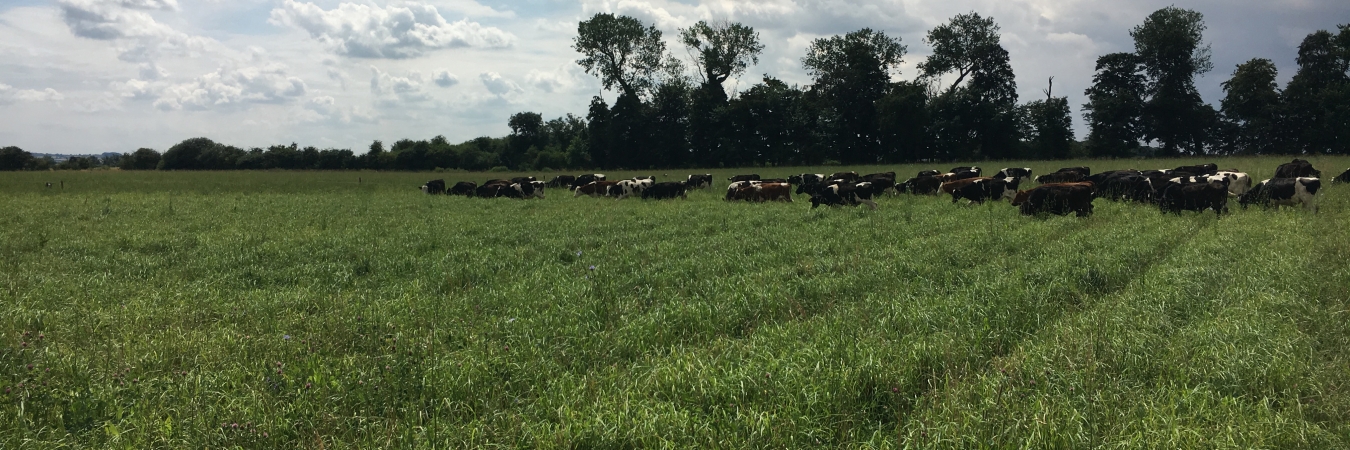Rotational benefits of leys – looking to the future
Now is a great time to be a soil scientist. A quick scroll through past Agricology blogs shows lots of interest in soil health – what it is, how we can measure it and what we can do to try and improve the condition of our soils. We know that continuous arable cropping with annual soil cultivations and little or no inputs of organic materials is responsible for the long term decline in soil organic matter levels in many soils. Soil organic matter is key to maintaining soil functions. If we want to try and reverse this trend and increase soil organic matter, we need to adopt management practices which increase inputs and reduce losses of organic matter.
Grass and herbal leys can help build soil organic matter through a combination of lack of tillage and root/residue returns as well as dung inputs from grazing animals. Farmers like Rob Richmond and John Cherry have described the soil quality benefits they’ve seen on their farms from temporary herbal leys. However, there is still quite a lot that we don’t know enough about. For example, the increase in soil organic matter content following a ley is likely to vary depending on soil texture and rainfall – we would like more information on how much we can increase soil organic matter content by including temporary leys in arable rotations. We also need to know more about the subsequent decline in organic matter content following return to arable production – how quickly do levels decline and what impact do ley destruction method and subsequent soil cultivations have? We also expect that there may be a ‘yield boost’ to the next crop following a temporary ley – but how much of a yield boost – what’s it worth and how long does it last?
We are currently working with AHDB Beef & Lamb on a project investigating the practical, economic, environmental and agronomic implications of integrating beef production into arable systems. As part of this project we’re working with a farm near Bath where a block of six long term arable fields were sown to 3 year temporary leys in autumn 2017. Measurements at this farm include detailed measurements of soil physical, biological and chemical properties and black-grass assessments (before and after the leys), livestock performance, yield benefits to the following arable crop, and an economic assessment from the perspective of both the arable unit and livestock producer. This project continues until 2022 and will give us really good information of the benefits and practicalities of integrating beef production into arable systems.
We wanted to broaden this project and work with farmers to try and address some of the longer term rotational benefits of integrating leys into the rotation across a wider network of farms. Last month ADAS and ADHB launched a new grass/herbal leys farm network aiming to do just this. We want the network to be a partnership between farmers, researchers and industry that provides a platform to investigate the long term impacts of leys in rotations. This is a great opportunity for farmers and researchers to work together and we’re inviting farmers, interested individuals and organisations to get involved.
Visual soil assessments prior to establishment of a grass ley. Photo credit: ADAS
To launch the network, a free meeting is being held on 19th April at Coventry Rugby Club for those interested in taking part. It will include a morning workshop with speakers discussing current knowledge on rotational benefits of leys followed by an interactive session where participants are invited to help steer and prioritise the activities of the network. We’ve had a really good response to this and we’re looking forward to the meeting in April. We still have spaces available so if you are interested in coming along, please get in touch. If you’d like to join the network, but are unable to make the meeting, please register your details and complete the short survey we have online and we will keep you informed of future developments.
Lizzie Sagoo writes of herself: “I joined ADAS as a soil scientist 15 years ago. Most of my work has focussed on sustainable soil and nutrient management practices. I’ve been involved in a number of projects investigating manure management strategies to maximise crop nutrient supply and minimise air and water pollution. At the moment I’m researching the sulphur supply from organic materials and the use of precision farming technology to improve soil and nutrient management, as well as the work with AHDB assessing the benefits of grass/herbal leys and integrating beef production into arable rotations. I’m really lucky to work with a great group of people at ADAS and to do a job which I find interesting and enjoy.”
Learn more:
- Find out more about the meeting being held to launch the network here.
- Access the survey Lizzie mentions here.
Browse the ‘Related content’ (to the right) to access other content on Agricology that explores improving soil quality through using herbal leys, incorporating leys within arable rotations, and combining beef production with arable systems.
(Editor’s Note)
Header image: Temporary leys can help build soil organic matter. Photo credit: ADAS

